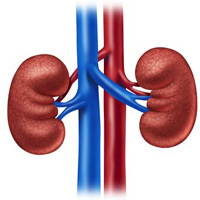Phyllanthus niruri and Chrysanthellum americanum in association with potassium and magnesium citrates are able to prevent symptomatic episode in patients affected by recurrent urinary stones: A prospective study

Accepted: April 26, 2021
All claims expressed in this article are solely those of the authors and do not necessarily represent those of their affiliated organizations, or those of the publisher, the editors and the reviewers. Any product that may be evaluated in this article or claim that may be made by its manufacturer is not guaranteed or endorsed by the publisher.
Objective: The aim of this study is to evaluate the efficacy of a food supplement containing Phyllanthus niruri and Chrysanthellum americanum in association with potassium and magnesium citrates in the treatment and prophylaxis of urinary stones.
Materials and methods: Eighty-two patients (mean age 49.7 ± 11.2) with history of urinary stones received this food supplement, one capsule a day for 6 months. Each administration contained a combination of the following ingredients: 244 mg Potassium citrate, 735 mg Magnesium citrate, Phyllanthus (Phyllantus niruri) herb d.e. 15% mg Tannins 220 mg, Chrysanthellum (Chrysanthellum americanum Vatke) plant d.e. ¼ 55 mg. After 6 months, all patients underwent urologic visit, urinalysis, imaging and quality of life (QoL) questionnaires evaluation. Each patient was also evaluated by computed tomography (CT) scan at baseline and at 6 months.
Result: From January 2018 to March 2019, 82 patients (mean age 49.7 ± 11.2) completed the follow-up period and were analyzed. Fifty patients showed lower stone dimensions (60.9%). The average stone size was 0.9 mm, with a significant reduction in comparison with the baseline (-6.7 mm ± 3 mm) (p < 0.001). Forty-nine patients (59.7%) did not show any symptomatic episode with an improving in QoL (+0.4 ± 0.1) (p < 0.001) in comparison with the baseline. At the end of the follow-up period, 27 patients out of 82 were stone-free (32.9%). Moreover, we report a significant reduction of patients with asymptomatic bacteriuria (ABU) between the baseline and the end of the follow-up evaluation (p < 0.001).
Conclusions: In conclusion, this food supplement is able to improve quality of life in patients with urinary stones, reducing symptomatic episodes and the prevalence of ABU.
Khan SR, Pearle MS, Robertson WG, et al. Kidney stones. Nat Rev Dis Primers. 2016; 2:16008. DOI: https://doi.org/10.1038/nrdp.2016.8
Cealan A, Coman RT, Simon V, et al. Evaluation of the efficacy of Phyllanthus niruri standardized extract combined with magnesium and vitamin B6 for the treatment of patients with uncomplicated nephrolithiasis. Med Pharm Rep. 2019; 92:153-157. DOI: https://doi.org/10.15386/mpr-1246
Curhan GC, Willett WC, Knight EL, Stampfer MJ. Dietary factors and the risk of incident kidney stones in younger women: Nurses’ Health Study II. Arch Intern Med. 2004; 164:885-91. DOI: https://doi.org/10.1001/archinte.164.8.885
Pucci ND, Marchini GS, Mazzucchi E, et al. Effect of phyllanthus niruri on metabolic parameters of patients with kidney stone: a perspective for disease prevention. Int Braz J Urol. 2018; 44:758-764. DOI: https://doi.org/10.1590/s1677-5538.ibju.2017.0521
Prezioso D1, Strazzullo P, Lotti T, et al. Dietary treatment of urinary risk factors for renal stone formation. A review of CLU Working Group. Arch Ital Urol Androl. 2015; 87:105-20. DOI: https://doi.org/10.4081/aiua.2015.2.105
Cruces IL, Patelli THC, Tashima CM, Mello-Peixoto ECT. Plantas medicinais no controle da urolitíase. Rev Bras Pl Med. 2013; 15(4 Supl 1):780-8. DOI: https://doi.org/10.1590/S1516-05722013000500020
Ettinger B, Pak CY, Citron JT, et al. Potassium-magnesium citrate is an effective prophylaxis against recurrent calcium oxalate nephrolithiasis. J Urol. 1997; 158:2069-73. DOI: https://doi.org/10.1016/S0022-5347(01)68155-2
Becchi M, Bruneteau M, Trouilloud M, et al. Structure of a new saponin: chrysantellin A from Chrysanthellum procumbens Rich. Eur J Biochem. 1979; 102:11-20. DOI: https://doi.org/10.1111/j.1432-1033.1979.tb06258.x
Kaplan RM, Bush JW, Berry CC. Health status: types of validity and the index of wellbeing. Health Serv. Res. 1976; 11:478-507.
Apolone G, Mosconi P. The Italian SF-36 Health Survey: translation, validation and norming. J Clin. Epidemiol. 1998; 51:1025-36. DOI: https://doi.org/10.1016/S0895-4356(98)00094-8
Micali S, Sighinolfi MC, Celia A, et al. Can Phyllanthus niruri affect the efficacy of extracorporeal shock wave lithotripsy for renal stones? A randomized, prospective, long-term study. J Urol. 2006; 176:1020-1022. DOI: https://doi.org/10.1016/j.juro.2006.04.010
Nishiura JL, Campos AH, Boim MA, et al. Phyllanthus niruri normalizes elevated urinary calcium levels in calcium stone forming (CSF) patients. Urol Res. 2004; 32:362-6. DOI: https://doi.org/10.1007/s00240-004-0432-8
Udupa AL, Sanjeeva, Benegal A, et al. Diuretic activity of Phyllanthus niruri (Linn) in rats. J Health. 2010; 2:511-2. DOI: https://doi.org/10.4236/health.2010.25076
Lojanapiwat B, Tanthanuch M, Pripathanont C, et al. Alkaline citrate reduces stone recurrence and regrowth after shockwave lithotripsy and percutaneous nephrolithotomy. Int Braz J Urol. 2011; 37:611-616. DOI: https://doi.org/10.1590/S1677-55382011000500007
Soygüur T, Akbay A, Küupeli S. Effect of potassium citrate therapy on stone recurrence and residual fragments after shockwave lithotripsy in lower caliceal calcium oxalate urolithiasis: a randomized controlled trial. J Endourol. 2002; 16:149-152. DOI: https://doi.org/10.1089/089277902753716098
Cicerello E, Ciaccia M, Cova G, Mangano M. The impact of potassium citrate therapy in the natural course of Medullary Sponge Kidney with associated nephrolithiasis. Arch Ital Urol Androl. 2019; 91. DOI: https://doi.org/10.4081/aiua.2019.2.102
Monti E, Trinchieri A, Magri V, et al. Herbal medicines for urinary stone treatment. A systematic review. Arch Ital Urol Androl. 2016; 88:38-46. DOI: https://doi.org/10.4081/aiua.2016.1.38
PAGEPress has chosen to apply the Creative Commons Attribution NonCommercial 4.0 International License (CC BY-NC 4.0) to all manuscripts to be published.


 https://doi.org/10.4081/aiua.2021.2.184
https://doi.org/10.4081/aiua.2021.2.184



